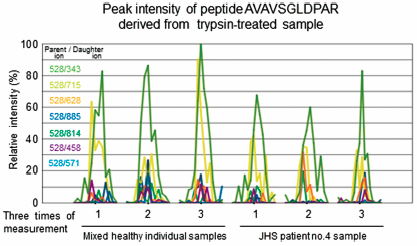- 著者
- Kazuo Yamada Atsushi Watanabe Haruo Takeshita Atsushi Fujita Noriko Miyake Naomichi Matsumoto Ken-ichi Matsumoto
- 出版者
- The Pharmaceutical Society of Japan
- 雑誌
- Biological and Pharmaceutical Bulletin (ISSN:09186158)
- 巻号頁・発行日
- vol.42, no.9, pp.1596-1599, 2019-09-01 (Released:2019-09-01)
- 参考文献数
- 15
- 被引用文献数
- 5 4
Joint hypermobility syndrome (JHS) (also termed hypermobility type Ehlers–Danlos syndrome, hEDS) is a heritable connective tissue disorder that is characterized by generalized joint hypermobility, chronic pain, fatigue, and minor skin changes. Initially, it was reported that there is a small subset of patients with JHS/hEDS who have haploinsufficiency of tenascin-X (TNX). However, the relationship between TNXB and JHS/hEDS has not been reported at all afterwards. EDS was reclassified into thirteen types in 2017, and the causative gene of JHS/hEDS remained to be identified. Therefore, in this study in order to determine whether JHS/hEDS can be diagnosed by the concentrations of serum form of TNX (sTNX), we measured the concentrations of sTNX in 17 JHS/hEDS patients. The sTNX concentrations in half of the JHS/hEDS patients were significantly lower than those in healthy individuals. No mutations, insertions or deletions were detected in the TNX exon sequence of the JHS/hEDS patients except for one in patient. That patient has a heterozygous mutation. A correlation between sTNX concentration and mutation of the TNXB genomic sequence was not found in the JHS/hEDS patients. These results indicate that the decrease in sTNX concentration could be used as a risk factor for JHS/hEDS.
- 著者
- Keiichiro Shibata Hidenori Yoshida Naomichi Matsumoto
- 出版者
- The Japanese Geotechnical Society
- 雑誌
- Japanese Geotechnical Society Special Publication (ISSN:21888027)
- 巻号頁・発行日
- vol.1, no.4, pp.7-10, 2015-08-30 (Released:2015-08-31)
- 参考文献数
- 8
The serious nuclear disaster in the Fukushima Daiichi nuclear energy plant of the Tokyo Electricity Power Company was occurred by the tsunami which was caused by the Great East Japan Earthquake on March 11, 2011. The radioactive materials emitted by the disaster were widely diffused in and around Fukushima prefecture including the Pacific Ocean by wind, rain and a flow of river. It can’t be always said that there is no risk of the condensation of radioactive materials in human’s body by ecological chain if fish take in radiation in the ocean contaminated by the radioactive materials. However the effective decontamination methods of the radioactive materials are not developed and the decontamination is less-advanced. The establishment of a new decontamination method is urgent need and indispensable in light of disadvantageous effect on ecological system. Thus, in this study, it is aimed to establish a new decontamination technology of radioactive materials deposited on seabed or lake bed. In particular, the new adsorption material which can adsorb radioactive materials is developed and the new method which can move them from the bottom sediment is proposed. The results obtained from various tests with or without the water circulation and the adsorption material indicate that the water circulation is effective and that the adsorption material has a great deal of potential in the decontamination of radioactive materials. It is expected that the proposed method and the developed adsorption material are efficient to remove radioactive materials from seabed or lake bed when they are expansively applied to the real decontamination.
